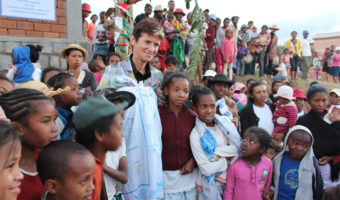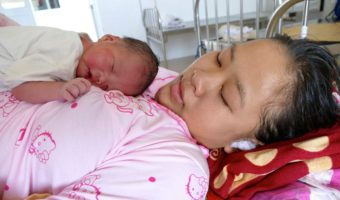Adolescent pregnancy is a global public health challenge. Most births to adolescents – 95% – occur in developing countries, where an estimated 21 million girls aged 15–19 became pregnant in 2016, of whom 12 million gave birth (Darroch et al., 2016). In those countries, an estimated 2.5 million girls under 16 give birth every year (Neal et al., 2012).
The current rate of 44 births per 1000 women aged 15–19 is down from 65 in 1990–1995, although progress has been uneven (United Nations Department of Economic and Social Affairs, 2015, 2017, 2018). Impoverished, poorly educated, rural girls everywhere are more likely to become pregnant than wealthier, urban, educated ones (United Nations Population Fund (UNFPA), 2013).
For some adolescent girls, pregnancy and childbirth are planned and wanted, within or outside marriage. For many, they are not and result from unplanned, sporadic or coerced sex. Many sexually active girls are unaware of contraception, do not want to use it, or do not have the agency to obtain it. When they try to get and use contraception, they may face restrictive laws or disapproving health workers and/or partner resistance (Chandra-Mouli et al., 2017).
Pregnancy and childbirth complications are the leading cause of death among girls aged 15–19. Additionally, some 3.9 million unsafe abortions occur annually, with serious consequences (Darroch et al., 2016). Early childbearing also increases risks for newborns, including low birthweight, pre-term birth and severe neonatal conditions (Ganchimeg et al., 2014). Unmarried pregnant adolescents may face stigma or rejection and adolescent mothers are more likely than older mothers to experience intimate partner violence (Chandra-Mouli et al., 2017). Studies suggest that young adolescent mothers who experience perinatal depression or are in difficult social situations may experience difficulties in securely attaching with, caring for and nurturing their babies and children (Figueiredo et al., 2006; Huang et al., 2014). Finally, early pregnancy often leads to school dropout, reduces employment opportunities, and perpetuates cycles of poverty (Loaiza and Liang, 2013).
In 2011, the World Health Organization and UNFPA published guidelines on preventing adolescent pregnancy and poor reproductive outcomes in developing countries, with six recommendations:
- reducing marriage before age 18
- creating understanding and support
- increasing use of contraception
- reducing coerced sex
- reducing unsafe abortion
- increasing use of skilled antenatal, childbirth and postnatal care. (WHO, 2011)
These recommendations have been endorsed by more recent reviews (Hindin et al., 2016).
Adolescent pregnancy prevention is high on the global agenda. Many governments are addressing it, although reports on achievements are only beginning to emerge. Here are three examples, from Chile, England and Ethiopia.
Chile
51% reduction in the proportion of births to mothers aged under 19 (2000–2017) (Paez, 2018)
How adolescent pregnancy was put on the national agenda
Recognising its high adolescent fertility rate (55.8 births per 1000 women aged 15–19 years in 2005), Chile adopted the regional 2007–2013 Andean Plan for the Prevention of Adolescent Pregnancy (Dides and Fernández, 2016; World Bank, 2019). Chile’s government targeted a 10% reduction in the adolescent fertility rate in the 2011–2020 National Health Strategy and strengthened the National Comprehensive Health Programme for Adolescents/Youth and the corresponding Strategic Action Plan (Gobierno de Chile, 2013).
How scale-up was planned
A five-pronged approach to improve the health system’s responsiveness to adolescents was developed for the ten-year strategy. New government circulars were issued on parental consent requirements, adolescents’ autonomy, and protecting young people from sexual abuse. Further, several laws were consolidated into one framework which defined and mandated different stakeholders’ roles and responsibilities (Gobierno de Chile, 2013, 2018).
How scale-up was managed
The programme built on functional systems by strengthening the capacity of frontline workers, and implemented its strategy gradually, starting with regions with the highest need (World Bank, 2019). To respond to the need for better data, a monthly statistical register was created to gather data on adolescents, disaggregated by age, sex, and risk factors.
How support was built, and resistance addressed
The programme drew legitimacy from regional/national plans and legislative frameworks. The Ministry of Health’s media department made data on progress available to journalists to publicise the positive results. Intensive advocacy with scientific associations, NGOs, women’s advocates and young people helped
to overcome resistance to contraceptive provision. However, the programme strategically decided not to provide education on sexuality to avoid risk of opposition to the broader agenda.
How sustainability was ensured
Grounding the approach in the ten-year National Health Strategy ensured sustained human and financial resources through three governments of left- and right-leaning political parties. Positive results encouraged other stakeholders to collaborate.
England
55% reduction in the under-18 conception rate (1998–2015) (Hadley et al., 2016)
How adolescent pregnancy was put on the national agenda (Hadley et al., 2016, 2017)
In the late 1990s the incoming government positioned teenage pregnancy as a cause and consequence of social exclusion which required collective action. Previous governments’ efforts had relied on the health sector, with little results. Strong advocacy from NGOs and medical organisations kept lack of progress high on the political agenda. The ten-year goal of halving the under-18 pregnancy rate, commitment to sustained resources, and launch by the Prime Minister secured the strategy as a national priority.
How scale-up was planned
Scale-up was integral from the start. A national programme, framed around four themes, was delivered by multiple agencies working together in all 150 local government areas with agreed local targets. Fundamental to the scale-up effort was the establishment of a structure which consisted of a national unit, nine regional teenage pregnancy coordinators and 150 local coordinators, and multi-agency partnership boards. A local implementation grant contributed to partnership building and joint implementation.
How scale-up was managed
Accurate and up-to-date conception data enabled a regular review of progress. A mid-strategy review comparing areas with contrasting progress found that regions that were applying all the recommended actions had demonstrated reduced rates, validating the strategy’s multi-component approach. More prescriptive guidance, direct engagement of government ministers and senior leaders in poor-performing areas, and tailored support helped to accelerate progress.
How support was built, and resistance addressed
The evidence-based strategy was strongly endorsed by NGOs and professional organisations. Trust was enhanced by the appointment of experts to an Independent Advisory Group, charged with holding the government to account. Its expertise was influential with local senior leaders and helped the government respond to negative media reporting by a small but vocal minority on the ‘dangers’ of sexuality education and providing confidential contraception to under-16s.
How sustainability was addressed
Sustaining progress beyond the end of the strategy and through a change of government posed challenges. However, the strategy had established awareness that adolescent pregnancy needed to be addressed and that the right actions had impact. Ministers called for further progress. Local leaders called for continued support and for updated national guidance. The adolescent pregnancy rate indicator was included in the public health dataset for monitoring national and local progress. Legislation for compulsory relationship and sexuality education in all schools (ages 5–16) from 2020 should embed prevention components of the strategy for future generations.
Ethiopia
29% increase in contraceptive use by married adolescent girls aged 15–19 (2000–2016), and 38% increase in postpartum contraceptive use among the same age group of married adolescent girls (2005–2016) (Central Statistical Agency (CSA) Ethiopia and ICF; Worku et al., 2015)
How teenage pregnancy was put on the national agenda
Within the context of the Millennium Development Goals, the Ethiopian government targeted maternal and childhood mortality reduction in rural areas, where over 80% of the population reside (Assefa et al., 2017).
How scale-up was planned
The Ministry of Health launched an ambitious Health Extension Programme (HEP) to deliver health education and basic health services in the community, and to strengthen linkages to health facilities. It aimed to empower rural households to ‘take responsibility for producing and maintaining their health’ (Assefa et al., 2009).
How scale-up was managed
Over five years, nearly 35,000 individuals (women in all regions except pastoral ones) selected by communities were recruited and trained as a new cadre of salaried health extension workers. In addition, mid-level health workers were recruited and trained to provide midwifery, neonatal and emergency care services in newly constructed or rehabilitated health centres. A core team, including technical experts and chaired by the State Minister of Health, reviewed progress, set priorities and developed plans. Problems that arose were identified and addressed (Assefa et al., 2009).
How support was built, and resistance addressed
The Ministry built support at national level through partnerships with professional associations of public health professionals and clinicians. At the local level, it engaged workers from the communities they would serve in, who were aware of the context and were trained and supported to engage in dialogue to challenge norms such as low utilisation of contraception or maternal health services (Assefa et al., 2009).
How sustainability was addressed
The government formulated laws guaranteeing free maternal and newborn health services in public health facilities and liberalising the law on providing abortion care in specified circumstances. Management and financing of the HEP, such as salaries for health extension workers and rehabilitation of health posts, were decentralised to regional and district levels, creating local ownership (Assefa et al., 2009).
Discussion and conclusion
Well-connected groups of change agents used available opportunities (a regional initiative in Chile, a new government in England) to create momentum for scaling-up adolescent pregnancy prevention.
All three countries planned scale-up systematically and pragmatically. They developed evidence-based strategies grounded in supportive national policies. They designated government departments to house and champion the efforts. They simplified the package of interventions to only the essential elements.
They communicated clearly what needed to be done, where, how and by whom.
All three countries committed adequate resources and managed implementation effectively. This required effort to engage and sustain the engagement of relevant government departments at different levels, NGOs and professional associations, and to ensure that an acceptable standard of quality was maintained. They used the findings of assessments and reviews to reshape their programmes.
England and Chile anticipated resistance to providing contraception to unmarried adolescents and worked strategically to address it. Ethiopia focused on young married women whose needs were widely acknowledged.
All three countries used data creatively to communicate the progress being made. They advocated for the efforts to be sustained and worked hard to sustain activities by integrating elements of the scale-up effort into wider national policies, strategies and indicator frameworks.
Adolescent pregnancy has clearly known causes, and serious health, social and economic consequences. There is consensus on the actions needed to prevent it. This knowledge has fed into national policies and strategies but has not yet resulted in documented examples of successful government-led national programmes. These case studies fill this gap. They show what can be achieved with the application of good science, with strong leadership and management, and with perseverance. They challenge us all to do what is doable and urgently needs to be done – now.
Acknowledgements
David Ross, WHO Geneva; Wegen Shirka, WHO Ethiopia; Teshome Desta, WHO Africa Regional Office
Sylvia Santander, Macarena Valdés, Cettina D’Angelo (all Ministry of Health, Chile)
References can be found in the PDF version of the article.



